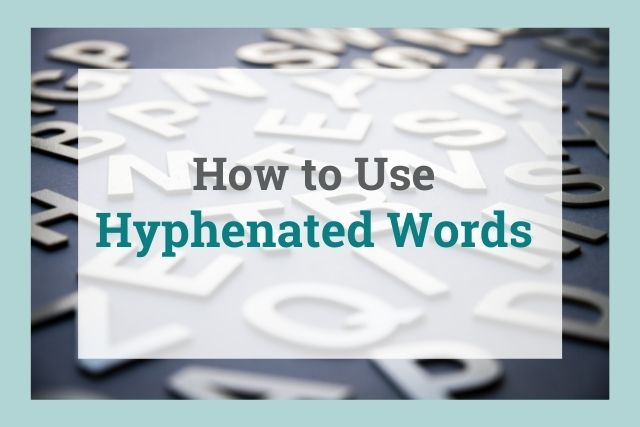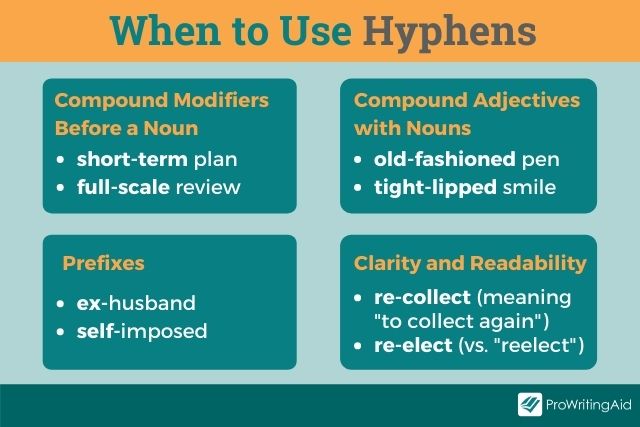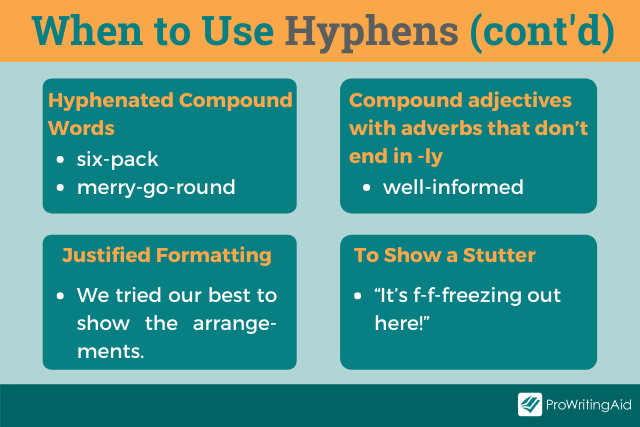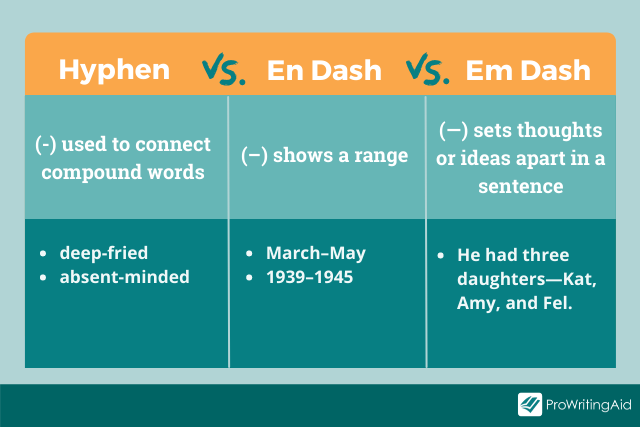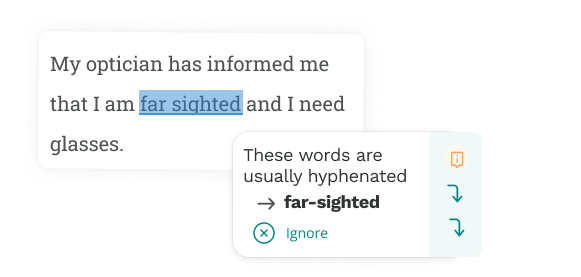Hyphenated words can be confusing for writers! There are many rules and guidelines on when to use hyphens. In today’s article, we’ll take a look at exactly what hyphenated words are and when to use them. We’ll go through plenty of examples so that you can use hyphenated words with confidence in your writing.
What Are Hyphenated Words?
A hyphenated word is a word that contains at least one hyphen. Typically, hyphenated words are compound words, which means the hyphen connects two or more words.
There are other uses of hyphens that we use in writing that aren’t compound words. We’ll cover these examples later in this article.
When to Use Hyphenated Words
We use hyphens to combine certain types of words. These include compound modifiers, such as adjectives and participles. We hyphenate many numbers when they are spelled out in word form, like twenty-one.
Sometimes, we hyphenate words after prefixes, but not every prefix requires a hyphen. How do you know which ones to use? We’ll cover these in more detail in a later section.
Hyphens can also help our writing become clearer. This means that occasionally, we can add hyphens where they aren’t required grammatically. Sometimes, that little punctuation mark can make a huge difference in improving clarity and readability.
Keep reading for detailed explanations of how and when to use hyphens in your writing.
Hyphens vs. Dashes
Many people confuse hyphens and dashes. We even say dashes when we’re using hyphens in web addresses, which makes things even more confusing.
But in English grammar, hyphens and dashes are very different. A hyphen is one short, horizontal line. You can find it next to the 0 on a QWERTY keyboard.
English also has two types of dashes, the en dash and em dash. The em dash (—) is a punctuation mark used between words to break apart thoughts or ideas within a sentence. It’s the length of two dashes.
The en dash (–) shows ranges between numbers, dates, etc. It’s wider than a hyphen and narrower than an em dash.
Many people use hyphens when they should use en dashes, or they’ll use two hyphens in place of an em dash. But these are three distinct punctuation marks and are not interchangeable.
Rules to Follow: What Words Should and Shouldn’t Be Hyphenated?
Hyphenation rules are tricky. Some words must be hyphenated, others should never be hyphenated, and still others can be hyphenated but don’t have to be. We’ll cover some of the basic guidelines for hyphenated words below.
Compound Modifiers
Sometimes when we describe a noun, we use two or more words together in place of one adjective. We call these compound modifiers. You might also hear them called compound adjectives.
There are several types of compound modifiers. One type is adjective + noun (or noun + adjective). We usually hyphenate these words. Here are some examples:
- short-term
- full-scale
- blue-collar
- skin-tight
- rock-hard
- world-famous
Another type of compound adjective combines an adjective with a past participle:
- old-fashioned
- tight-lipped
- good-hearted
- deep-fried
- absent-minded
Adjectives can also combine with a present participle:
- good-looking
- slow-going
- quick-thinking
Nouns can also combine with past and present participles by using a hyphen to make a compound modifier:
- record-breaking
- mind-numbing
- sun-kissed
- air-fried
Some hyphenated compound modifiers are two adjectives, like the examples below:
- fat-free
- bluish-purple
- topsy-turvy
There are also hyphenated compound modifiers that include adverbs, but these get tricky. We’ll cover adverbs in a later section.
Numbers 21 through 99
In English, we hyphenate many two-digit numbers in their written form. Any base-ten higher than twenty plus an integer one through nine is hyphenated. What does this mean? Here are some examples:
- twenty-one
- thirty-two
- forty-three
- fifty-four
- sixty-five
- seventy-six
- eighty-seven
- ninety-eight
We don’t hyphenate teens (e.g. sixteen, seventeen), nor numbers higher than 99.
Let’s look at an example of a large number, so you can see where the hyphen goes:
- 273 = two hundred seventy-three
Notice that we do not hyphenate “two hundred.” We also don’t need the word “and” because in mathematics “and” denotes a decimal. Outside of math, we can place the word “and” to mimic how many people speak. It would look like this:
- two hundred and seventy-three
What about even bigger numbers? Here’s an example:
- 24,535 = twenty-four thousand five hundred [and] thirty-five.
Once again, the “and” is optional. Our hyphenation rules remain the same no matter how large the number gets.
If it’s read like a base-ten plus a number (e.g. twenty-four), we hyphenate. The words “hundred,” “thousand,” “million,” and so on, do not need hyphens.
Compound Adjectives with Numbers
Some compound modifiers contain numbers. These might be periods of time or ages. We hyphenate any compound adjective that contains a number if it precedes a noun. Here are some examples:
- two-week vacation
- three-day weekend
- five-year-old boy
- seventy-three-year-old grandma
- seven-year itch
- fifteenth-century castle
- second-place medal
- third-grade class
If there is a number in a compound adjective, it must have a hyphen. However, if it’s not part of a compound adjective that precedes a noun, we do not hyphenate the word:
- I’m on vacation for two weeks.
- The boy is five years old.
- The castle was built in the fifteenth century.
- She teaches third grade.
- I came in second place.
Always ask yourself how the phrase is functioning. If it’s a compound adjective that contains a number, use a hyphen!
Certain Prefixes
Prefixes are letters or words that attach to the beginning of a word to make a new word. Usually, we do not need to add hyphens after prefixes. However, some prefixes require a hyphen.
When we use the prefix “ex-” to mean “former,” we use a hyphen. Ex- has several meanings as a prefix, and some do not require a hyphen.
If you aren’t sure, try replacing the prefix with the word “former.” If it still makes sense, add a hyphen. If not, the hyphen is probably unnecessary.
- ex-husband
- ex-member
- ex-coworker
So, you wouldn’t need it for words like “excommunicate.” The meaning of the prefix is different.
If you’re using “self-” as a prefix, always add a hyphen. Don’t confuse this with the root word “self” that stands alone as a noun! Here’s what it looks like as a prefix.
- self-loathing
- self-confidence
- self-imposed
You can think of these as compound modifiers instead of a prefix if it helps you remember to use the hyphen.
Likewise, if you’re using “all-” as a prefix, it functions like a hyphenated compound modifier. Let’s look at some examples:
- all-encompassing
- all-powerful
- all-in
You should also hyphenate words that have prefixes before capitalized words, such as “un-American,” “pro-Palestinian,” or “post-Depression era.”
Some words that contain other prefixes have hyphens, but these will occur on an individual basis rather than as a hard and fast rule.
Hyphenating for Clarity
Just when you think hyphenating words was easy once you learn the rules, you find out that some hyphenation rules are optional!
Every now and then, you might write a word that is difficult to read without a hyphen. This often occurs when a prefix shoves two identical letters together.
In these situations, you can add a hyphen to make your writing easier to read. Words like “pre-eclampsia” or “re-elect” are easier to read with the hyphen, even though it’s not necessary.
Hyphens can also help ensure that readers emphasize a syllable correctly to avoid confusion with another word. “Re-collect” will tell the reader you mean “to collect again” rather than “recollect” or “remember.”
Hyphens and Adverbs
Adverbs often combine with other words to form compound modifiers. Sometimes, we need hyphens. Other times, we don’t. How do you remember when to use a hyphen with an adverb?
If the adverb ends in -ly, do not use a hyphen. Take a look at these examples:
- beautifully dressed
- heavily laced
- happily married
- horribly disfigured
- poorly written
But not all adverbs end in -ly. Here are some examples of compound modifiers with adverbs that do need a hyphen:
- well-informed
- never-ending
- far-sighted
- even-keeled
If you aren’t sure when to use a hyphen with adverbs, ProWritingAid can help. The Grammar Report will point out missing and unnecessary hyphens.
Examples of Hyphenated Compound Words
Compound words are words that are comprised of two or more words, often nouns, to create a new word. There are open compound words, closed compound words, and hyphenated compound words.
Open compound words include words such as coffee table, dining room, high school, ice cream, and peanut butter. There’s a space between these words, but both parts of the word are necessary. Peanut and butter are two different things than peanut butter.
Closed compound words push words together without a space or hyphen. Words such as mailbox, skateboard, sunshine, bookshop, and firefighter are closed compound words.
Some compound words used to be hyphenated but eventually the hyphen went out of fashion.
Hyphenated compound words use a hyphen to connect the words. Here are some examples:
- six-pack
- merry-go-round
- runner-up
- king-size
- editor-in-chief
Hyphenated compound words like this differ from compound modifiers because they are nouns that are always hyphenated. They don’t function as adjectives or modifiers.
Other Uses of Hyphens in Writing
Hyphens have other uses in English writing, too. They don’t always form new words or connect parts of speech. Sometimes, they are used for formatting purposes.
When we justify text, or line up both margins, words can get cut off. While you can place a long word on the next line, this can look messy and uneven, particularly in books. Hyphens are used to cut words off between lines.
Hyphens can also denote a stutter or stammer in dialogue, as in this example:
- “It’s f-f-freezing out here!”
These are formatting rules more than grammar rules, but it’s important to know that we can use hyphens in this way.
Conclusion on Words with Hyphens
Hyphens are a tiny punctuation mark that nonetheless pack a punch. Always ensure you are using a hyphen instead of an en dash or em dash when hyphenating words.
Remember to use hyphens in most compound modifiers, and always run your writing through an editing program like ProWritingAid to catch any hyphen errors.
Take your writing to the next level:
20 Editing Tips from Professional Writers
Whether you are writing a novel, essay, article, or email, good writing is an essential part of communicating your ideas.
This guide contains the 20 most important writing tips and techniques from a wide range of professional writers.

Asked by: Jettie Rau Sr.
Score: 4.1/5
(45 votes)
A hyphenated compound word is a term composed of two (or more) words connected by a hyphen. Like other compound words, a hyphenated compound can be a noun, adjective, or adverb.
What is the example of hyphenated compound words?
Note that hyphenated compound words are most commonly used when the words being joined together are combined to form an adjective before a noun. For example: forty-acre farm. full-time worker.
What hyphenated examples?
Use a hyphen to join two or more words that stand for a single adjective (describing word) before a noun. Examples: chocolate-covered donuts. well-known doctor. much-needed vacation.
What are the hyphenated words?
The hyphen ‐ is a punctuation mark used to join words and to separate syllables of a single word. The use of hyphens is called hyphenation. Son-in-law is an example of a hyphenated word.
Are hyphenated words compound words?
Compound words can be written in three ways: as open compounds (spelled as two words, e.g., ice cream), closed compounds (joined to form a single word, e.g., doorknob), or hyphenated compounds (two words joined by a hyphen, e.g., long-term). Sometimes, more than two words can form a compound (e.g., mother-in-law).
32 related questions found
How do you know if a word is a compound word?
A compound word is a union of two or more words, either with or without a hyphen. It conveys a unit idea that is not as clearly or quickly conveyed by the component words in unconnected succes- sion.
Are compound nouns hyphenated?
Compound nouns comprised of a noun and a participle (in any order) must be hyphenated when being used as an adjective: a garden-filled city, cutting-edge methods. Otherwise, no hyphens are needed.
What is a hyphen look like?
Alternatively known as a dash, subtract, negative, or minus sign, the hyphen ( — ) is a punctuation mark on the underscore key next to the «0» key on US keyboards. Pictured is an example of the hyphen and underscore key on top of the keyboard. … Keyboard help and support.
Is a hyphenated word one word?
The reason is quite simple—the generally accepted rule is that a compound word is always treated as a single word. For instance, the compound adjective «real-time» is a different word than «real time.» … So, once compound words are closed or hyphenated, they are counted as one word.
Why are words hyphenated?
Hyphens’ main purpose is to glue words together. They notify the reader that two or more elements in a sentence are linked. Although there are rules and customs governing hyphens, there are also situations when writers must decide whether to add them for clarity.
What is a hyphenated sentence?
Hyphens serve to remove confusion from sentences, and to combine multiple words to form a single meaning. … For instance, in the sentence, “Lord Emsworth belonged to the people-like-to-be-left-alone-to-amuse-themselves-when-they-come-to-a-place school of hosts.” (Something Fresh by P.G.
How is a hyphen used in a sentence?
Hyphens connect two words to make a single word. Hyphens are also used to attach a prefix to a word. In some situations, hyphens connect adverbs and adjectives to describe a noun. … The placement of a hyphen can greatly change the meaning of a word and thus the entire sentence.
Where do you use a hyphen in a sentence?
Generally, you need the hyphen only if the two words are functioning together as an adjective before the noun they’re describing. If the noun comes first, leave the hyphen out. This wall is load bearing. It’s impossible to eat this cake because it is rock hard.
What is the example of compound words?
Compound words are formed when two or more words are joined together to create a new word that has an entirely new meaning. Click here for Compound Words Games, Videos, Quizzes, Worksheets and Lessons. For example, “sun” and “flower” are two different words, but when fused together, they form another word, Sunflower.
Is Top 5 hyphenated?
Hyphenate when top five is used as a compound modifier. Otherwise, no hyphen. Example: The University of Florida is a top-five public university.
Is Outbrief one word?
Outbrief has no English definition. It may be misspelled.
How do I type a hyphen?
Hold down the Alt key, press 0 1 5 0 on the numeric pad, and then release the Alt key. The en dash will appear in the text field where your cursor is.
Is a hyphen the same as a dash?
They might all look like lines on a page, but hyphens and dashes serve different purposes. To begin, a hyphen (-) is shorter than a dash (–). Hyphens join words together and dashes indicate range.
What is the difference between hyphen and underscore?
Google views hyphens in URLs as word separators while an underscore in your url will not be recognized. This means using hyphens makes it much easier for Google to figure out what a page is about. For example, a URL containing the phrase «my_page» would be interpreted as «mypage» instead of «my page».
How do you identify a compound noun?
A compound noun is usually [noun + noun] or [adjective + noun], but there are other combinations (see below).
…
Compound Nouns
- open or spaced — space between words (tennis shoe)
- hyphenated — hyphen between words (six-pack)
- closed or solid — no space or hyphen between words (bedroom)
What words are compound words?
Compound words are comprised of two smaller words that join together to create a new meaning. Three types of compound words are closed, open, and hyphenated. Sometimes the meaning of a compound word can be determined from its parts, and sometimes the new word means something completely different.
Is anything a compound word?
The compound nouns Anybody, Anyone, Anything and Anywhere are generally used in negative sentences and questions as objects, but are only used as subjects in positive sentences. Anybody, anyone, anywhere and anything refer to one of many people, places or things.
Scientists are big into molecular compounds, and there is something kind of magical about them. You can start with a couple of atoms of hydrogen, add another atom of oxygen, and bada bing: water. Two distinct elements come together to create something entirely different.
It’s exactly the same with words. Well, maybe not exactly the same, but English is such a flexible, creative language that it’s filled with compound words—and new ones are popping up all the time to suit our ever-changing world. Some useful compound words recently added to Merriam-Webster are clickbait, photobomb, binge-watch, humblebrag, and spit-take.
So what is a compound word? How do you know whether it should be a closed compound, a hyphenated compound, or an open compound? What about compound sentences? We’ll look at all of these in this post.
When two (or occasionally, three) words work together to express a single idea, that’s a compound word. Compound words can be open, closed, or hyphenated, and they can function as nouns, adjectives, or adverbs. English is full of preexisting compound words—or you can make up your own to suit the situation.
No one at the Star Trek convention really appreciated my Klingon-librarian costume.
The lung-collapsing dead-flower stench of my aunt Penelope’s perfume was headache-inducingly strong.
What is an open compound word?
An open compound word is two separate words (without even a hyphen to link them) functioning as a single idea.
When we were in high school, we regularly ate French fries, hot dogs, and ice cream with peanut butter as an afterschool snack.
What is a hyphenated compound word?
A hyphenated compound word is a term composed of two (or more) words connected by a hyphen. Like other compound words, a hyphenated compound can be a noun, adjective, or adverb.
The gun-toting, card-carrying FBI agent hid her angst well.
What is a closed compound word?
A closed compound word is a single word constructed of two or more other words. Most closed compound words were once open or hyphenated, but continued use solidified them—made them a single unit. Today’s open or hyphenated compounds are tomorrow’s closed compounds.
The moonlight coming through my bedroom window is so bright it outshines my flashlight.
Every afternoon, she wrote another story in her notebook; my favorite is the one about the starfish who loved rainbows and strawberries.
How do you know whether a compound word is open, hyphenated, or closed?
There’s really no trick to this! You look it up in a dictionary (like Merriam-Webster). Compound words evolve over time, so what was once black-bird is now blackbird, and what was once a web site is now almost always a website.
Don’t worry if you find dictionaries contradicting each other! Not every dictionary agrees on which compounds are open, hyphenated, or closed. Some offer health care and voice mail, for example, as two words, but others hyphenate or close those same compounds. In such cases, you’re free to use the spelling you prefer, except if you’re supposed to be following a particular style guide.
For example, the Chicago Manual of Style (CMoS) says that when a compound modifier comes before a noun, it’s never wrong to hyphenate it, since it can aid readability.
The seventy-year-old professor despaired for the dull-witted students in her late-afternoon class.
But (Chicago goes on to say) when compound modifiers follow the noun, leave them unhyphenated (even if they’re hyphenated in the dictionary).
The professor, who was almost seventy years old, couldn’t understand why her students were so dull witted by late afternoon.
What is a compound noun?
Compound words can be nouns, adjectives, adverbs—and even verbs (like pole-vault or double-click). In each case, they can be open, hyphenated, or closed. Compound nouns are perhaps the most common type of compound word. Here are some examples of compound nouns (some closed, some open, some hyphenated).
Susan’s grandmother, my mother-in-law, had a skylight above the bookcase in her living room that let in rainwater.
Watch out for the sometimes-unusual plurals of hyphenated compound nouns.
The workmen fixing the two merry-go-rounds in the local park typically catcalled all passersby, but they stopped once our attorneys-at-law sent them a warning.
What is a compound name?
A compound name is essentially a compound proper noun—a multiword term (often an open compound, though not always) that names a single entity.
Like Popeye, Black Panther gets at least some of his powers from eating his greens—in his case, the heart-shaped herb. But I bet Superman liked Cheez-Its better.
What’s important here is that these proper nouns are always preexisting compounds, so if you’re turning an open compound name into part of a compound modifier (see more about compound adjectives and adverbs below), you’ll need to use an en dash rather than a hyphen.
My new World War I–era cloche didn’t really go with anything in my New York–style wardrobe, so naturally I had to go shopping.
What is a compound adjective?
A compound adjective is a single adjective made up of more than one word—and it’s often a compound noun (or even compound name) being used to modify another noun. According to CMoS, it’s never wrong to hyphenate multiword adjectives when they precede a noun, even if they’re familiar open compounds like high school.
High-school students often have more brain-draining homework than college students.
My silly-voiced sister found her calling in advertising.
When a compound name functions as an adjective, there’s no need for a hyphen.
Penny was thrilled to win Dolly Parton tickets.
The Los Angeles weather is typically hot and sunny.
As touched on above, when a compound adjective follows a noun, the hyphen is usually not necessary.
Georgia is a well-read academic.
Georgia is well read.
I found a useful list of low-calorie cocktails.
I found a useful list of cocktails, all of them low calorie.
Remember that compound adjectives made from an adverb ending in –ly plus an adjective are never hyphenated. The -ly is enough of a signal that what follows is meant to be read together with the preceding word.
Sarah’s short-tempered grandfather griped about her recital, calling it a really dull concert.
Sarah’s grandfather, always short tempered, griped about her recital, describing it as really dull.
What is a compound adverb?
A compound adverb looks like a single word but (closely examined) is actually made up of two or more words working together to function as a single adverb. They’re often rather old fashioned, and they can sound stuffy and pompous so are best used sparingly: notwithstanding, nevertheless, heretofore, albeit, and so on.
Phrasal adverbs are very similar to compound adverbs, and they’re rather more useful.
I scattered rose petals here and there.
The newly married couple walked arm in arm.
Joseph goes running every day.
What is a compound sentence?
And here’s the bonus section (because the last thing we want to do is compound anyone’s confusion about compounds)!
Compound sentences are grammatically unrelated to compound words, but that still doesn’t answer the key question: What is a compound sentence? A compound sentence is when two or more independent clauses, each with its own subject and verb plus attendant objects and phrases, are joined with a coordinating conjunction (one of the FANBOYS: for, and, nor but, or, yet, so). Here, the key thing to remember is to always include a comma after the first independent clause and before the conjunction.
I read this blog post about compound words, but they didn’t explain about compound sentences, so I had to keep on searching.
My son’s story about the strawberry-loving starfish was really cute, so I sent it to my sister, and she loved it too.
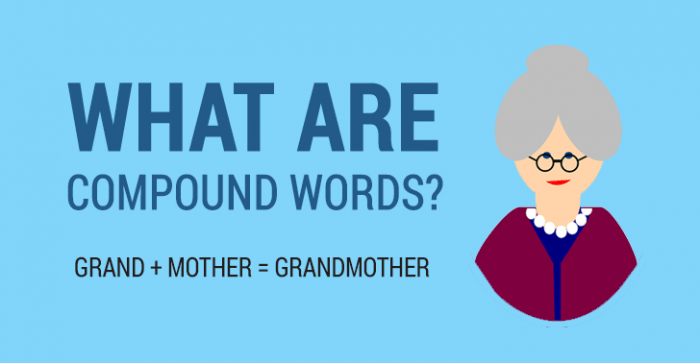
What are Compound Words?
It’s best to define compound words with an example:
Grand + Mother
On their own, both these words have separate meanings. But when you put these two words together, it creates an entirely different word and meaning.
Grandmother
For compound words, when you put two different words together, it forms another word and meaning. There are different types of compound words. For example, compound words can have hyphens, spaces, or no spaces at all between the two words.
Types of Compound Words
Over time, English has morphed itself. As a result, people have created new types of compound words. In turn, this language gets passed along and circulated to what it is today.
In terms of compound words, they’ve transformed into various types. For example, compound words can have hyphens, spaces, or no spaces at all between the two words. There are 3 types of compound words:
- Hyphenated Compound Words
- Closed Compound Words
- Open Compound Words
Below, we have added lists of examples for all the types of compound words.
Hyphenated Compound Words Examples
Hyphenated compound words place a hyphen between the two words. For example, “well-being” is a hyphenated compound word because it connects two words together with a hyphen.
HYPHENATED COMPOUND WORDS
- High-speed
- Empty-handed
- Mass-production
- High-tech
- Deep-fried
- Left-handed
- In-depth
- Full-length
- Part-time
- Time-saving
- North-east
- Sun-dried
- Long-haired
Closed Compound Words Examples
Closed compound words don’t have any spaces between the two combined words. For example, “playground” is a closed compound word because it doesn’t have a space between it.
CLOSED COMPOUND WORDS
- Playground
- Footprint
- Fishbowl
- Grasshopper
- Bookmark
- Keyhole
- Bowtie
- Popcorn
- Basketball
- Horseshoe
- Keyboard
- Notepad
- Skateboard
Open Compound Words Examples
Open compound words put two words together to create a meaningful weird but use a space to separate them. For instance, high school is an open compound word.
OPEN COMPOUND WORDS
- High school
- Living room
- Roller coaster
- Peanut butter
- First aid
- Web page
- Hot dog
- Voice mail
- Table cloth
- Fire drill
- Ice cream
What’s Next?
What do Superman, Robocop, and Catwoman all have in common?
They’re superheroes! Yes. But they’re also all compound words too. Actually, there are compound words everywhere.
And they’re tons of fun to teach with our free compound words worksheets. What are some of your favorite compound words?
And if you want to teach compound words, check out our free compound words worksheets that you can use in your classroom today.
A hyphenated compound is made from two words in English combined by a hyphen. The two words are often adjectives or nouns, and can be used by themselves, but combined with a hyphen they represent a different thing. Common examples are “part-time,” “high-speed,” and “editor-in-chief.” Because English is not completely consistent, and because the written language changes, the use of a hyphenated compound is not always regulated.
The hyphenated compound is generally the least used form of compound word. Often words will begin as an open compound, progress into a hyphenated compound, and with frequent use in the English language, are combined in the common lexicon as one word. An example is the combination of the two words “key” and “board” used separately to describe a computer tool in the early days of its use. They are then combined after some usage into a hyphenated compound: “key-board.” Often, when this usage becomes common, the hyphen gradually gets dropped and the term becomes a one-word compound: “keyboard.”
Modifying and descriptive pronouns often use a hyphenated compound to avoid confusion. Descriptive words like big-time, yellowish-green, and high-rise are combined to make sentences more clear and to combine two unrelated words into one idea. A term like “high-danger situation,” without a hyphenated compound could create confusion. The term obviously refers to a situation with imminent danger. Without the hyphen it would read “high danger situation,” and could describe the same as the hyphenated situation, or it could describe a “high” situation (as in elevated), with a threat of danger (not necessarily “high”). This new construction alters the meaning completely.
Also, English terms with words in the middle or more than two words are usually hyphenated, such as merry-go-round, father-in-law, or ten-year-old. In cases like these, most of the time the term is made plural by adding an “s” to the last of the set of words. In some unusual cases, though, the term is made plural by adding an “s” to the first word, usually the noun, such as “attorneys-at-law.”
Many words began as one type of compound in England under the Germanic languages, but changed to another type of compound after the altering of the language in 1066 with the Norman invasion. Some words have just been changed throughout time because of awkward spelling or usage, and some words, like the original title of Herman Melville’s “Moby-Dick,” were just dropped because they made more sense or seemed more natural without a hyphenated compound.

